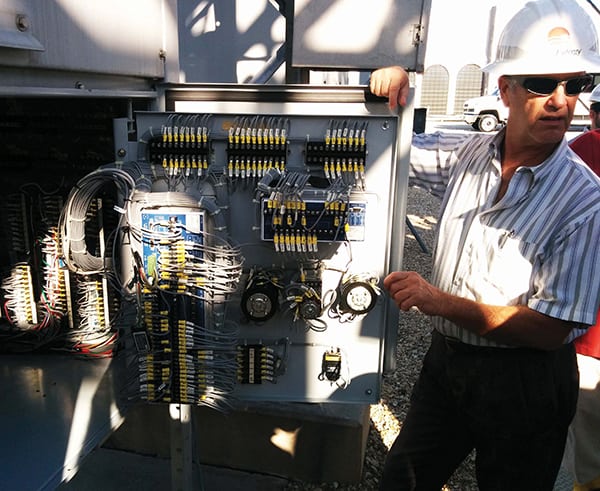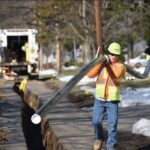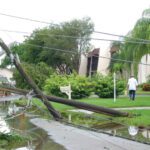Hurricanes, tsunamis, and climate change—operating a power plant on the seacoast carries with it an array of unique challenges. Here’s what some generators are doing to ensure the lights stay on when Mother Nature comes calling.
Like experienced sailors, power plants located along a coastline have always looked at the sea as both a friend and a potential enemy. Ocean waters provide vital plant cooling, but the ocean can also bring floods, storms, and heavy surf that can wreak havoc with plant operations. That means that designing, building, and operating a plant along a coast requires a healthy respect for the sea’s unpredictability.
That’s always been the case, but coastal resiliency issues have taken on new prominence in recent years as a result of major natural disasters such as Hurricanes Katrina and Sandy, and more insidious threats such as climate change–induced sea-level rise.
The scope of the threat depends on whom you ask, but there’s little dispute that it’s growing. Even adjusting for inflation, the incidence of disasters causing more than a billion dollars of damage has been increasing, in part because coastal infrastructure has been expanding over the past decades: There is simply a lot more coastal property vulnerable to damage, including power plants. Even though once-through cooling (OTC) is being replaced by more environmentally friendly methods, in many cases, new power plants relying on air cooling are replacing plants that relied on OTC on the same sites.
According to data from the U.S. Energy Information Administration, reported weather-related outages have increased substantially in frequency over the past two decades even as outages from other causes have remained flat. While much attention has been devoted to transmission infrastructure—such as hardening grids through various means such as burying power lines, better protecting transformers and substations from severe weather, and leveraging microgrid and other advanced transmission technology such as fiber optics (see sidebar)—power plants remain key anchors, because electricity can’t be turned back on after a disaster if area power plants are offline as a result of damage.
Flood Tide
Perhaps the largest threat to coastal power plants is storm-related flooding, whether as a result of a hurricane storm surge, heavy rains, or some other threat. During Hurricane Sandy, Exelon’s Oyster Creek nuclear plant and Unit 1 at Salem Generating Station (jointly owned by PSEG and Exelon, Figure 2), both in New Jersey, experienced abnormally high intake water levels. Salem was forced to shut down, while Oyster Creek—offline for refueling—had to declare an alert.
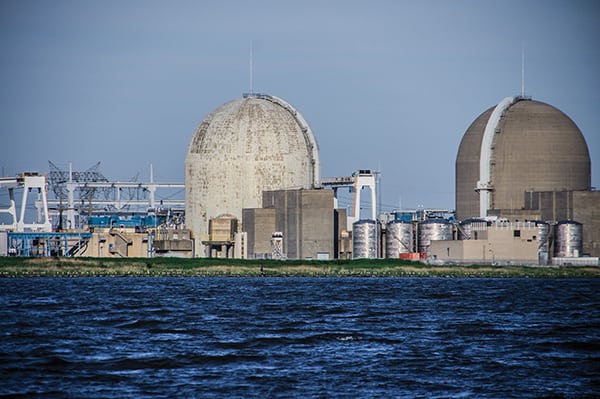 |
|
2. Blown out. Unit 1 at Salem nuclear power plant was forced offline during Hurricane Sandy when the storm surge entering Delaware Bay caused dangerously high intake water levels. (Unit 2 was already offline for refueling.) The plant shut down safely, and no damage was sustained. Courtesy: Peretzp/Wikipedia |
PSEG’s New Jersey fleet took a body blow from Sandy, which landed a direct hit on the Jersey Shore south of New York City. The company saw nearly 4 GW of capacity knocked offline by the storm. At one plant, the 452-MW natural gas–fired Kearny Generating Station, the company had dedicated six new peaker units totaling 270 MW scarcely a week before Sandy hit. Nearly all of PSEG’s customers experienced some sort of outage. As a result, PSEG is in the middle of a multi-billion-dollar initiative to harden its fleet against future storms.
But severe storm planning is an ongoing process.
Awareness of potential risks from storm surges has grown since Sandy. Duke Energy, with numerous plants along the Atlantic and Gulf coasts, has made protection from storm surge much more of a priority for its future plants. Wayne Toms, manager of Duke’s 1,113-MW Bartow Station in St. Petersburg, Fla., explained to POWER in an interview how the company’s Citrus County Combined Cycle plant, which broke ground north of Tampa in March about 2.5 miles from the Gulf of Mexico, has been designed so that all of its key equipment is elevated well above mean sea level (Figure 3). Duke had originally designed the site to ride out a generic 100-year flood, but planners ultimately decided that planning for possible storm surges was more prudent.
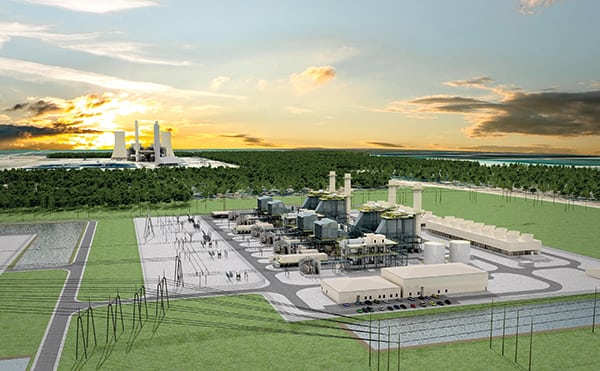 |
|
3. Storm ready. Duke’s new Citrus County Combined Cycle plant, under construction near Tampa, Fla., was designed to withstand a Category 3 hurricane storm surge. All super-critical equipment will be elevated 24 feet above mean sea level. Courtesy: Duke Energy |
“We designed for a Cat 3 storm surge, which is about 21 feet above mean sea level, so our super-critical equipment will be 24 feet in the air, and our critical equipment is designed for a Cat 2 storm surge, which is about 16 feet above sea level.”
Duke’s experience with multiple hurricanes over the past decade or so caused it to reassess its severe storm planning. Toms, who was operations manager of the Crystal River plant during some of those storms, said that because of the flooding they experienced, they realized previous approaches weren’t enough. “We went back and re-wrote our procedures for these kinds of events to increase the number sandbags and other equipment we needed to keep the water out.”
Fuel and Staff Planning
Planning for fuel supply is also an element of storm preparedness for coal-fired plants, Toms noted. “The hurricane season starts June 1, and at Crystal River, we tried to have at least 60 days of coal on the ground.” Some of the coal for Crystal River comes across the Gulf of Mexico on barges from the Mississippi, and in bad weather, the barge deliveries can get curtailed.
Storm planning also includes preparation for plant staff. Toms said that when a hurricane is approaching, they will send half the staff home for 24 hours to handle their personal planning for their families, then allow the other half to go home 24 hours later when the first group returns.
Whether to shut the plant down entirely depends on a number of things, including how close the storm would pass over the plant. “If we knew the storm was going to hit us directly, the plant would be shut down, period, and everybody would be sent home, and we would come back afterward to pick up the pieces. That’s just the way we operate.” If there wasn’t enough warning to shut down the plant—Toms said they needed 36 hours for a safe shutdown of Crystal River—then a skeleton staff of five or six people would remain on site in the control room to ride it out.
Long-Term Horizons
Working from its experiences with Hurricanes Katrina and Rita, Entergy sent some waves through the power sector in 2010 when it launched an initiative to analyze and quantify the risk its service area along the Gulf Coast faced from future climate change. What it found was that the region could expect more than $350 billion in potential damages from all environmental factors by 2030. This represented a combination of increased hurricane severity (as a result of ocean warming), subsidence, sea-level rise, and other factors. One projection had New Orleans effectively turned into an island by 2100 as a result of a net sea level rise of just 1 meter.
The study identified a number of mitigation and adaptation methods that would reduce potential damages. One—building levees around key infrastructure—though expensive, was identified as an important piece of the puzzle because of its high return in the event of a disaster. Another, wetlands restoration, was also highlighted for its ability to mitigate storm surges and effects of subsidence and coastal erosion.
“Entergy has worked to develop a framework and fact base to quantify climate risks in the U.S. Gulf Coast and help inform economically sensible approaches for addressing this risk and building a resilient Gulf Coast,” Entergy Louisiana spokesman Michael Burns told POWER.
According to Burns, the company views its response to climate change as an ongoing process, and continues to track and monitor changes in the Gulf Coast environment. ■
—Thomas W. Overton, JD is a POWER associate editor.


